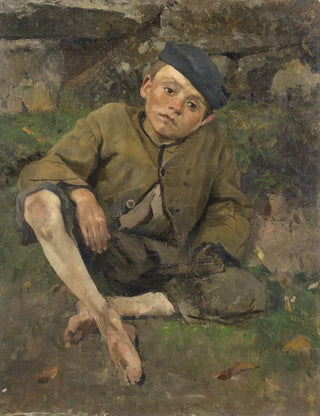Art print | The Little Invalid - Richard Bergh


View from behind

Frame (optional)
In the rich and varied landscape of art history, certain works manage to capture the essence of humanity with such intensity that they transcend time and space. "The Little Invalid" by Richard Bergh is one of these creations. This piece, which reveals the subtleties of the human condition through the gaze of a child, invites us to a deep reflection on the fragility and beauty of life. Offering a window into the soul of its subject, Bergh reminds us that every individual, regardless of their condition, deserves to be seen and heard. The art print The Little Invalid - Richard Bergh allows us to access this emotional experience while immersing us in the delicate world of early 20th-century art.
Style and uniqueness of the work
Richard Bergh's style is distinguished by its intimate approach and ability to capture moments of vulnerability. In "The Little Invalid," the artist uses a palette of soft colors and delicate brushstrokes to create an atmosphere filled with tenderness. The child, at the center of the composition, is depicted with an expressiveness that evokes both sadness and hope. The meticulous details of the face and hands demonstrate particular attention to the representation of innocence and suffering. This painting does not merely depict a subject; it tells a story, that of a human being facing challenges but remaining luminous and full of life. The light, caressing the child's face, symbolizes hope and resilience, thus adding a poetic dimension to the work.
The artist and his influence
Richard Bergh, an emblematic figure of the Dutch artistic movement, knew how to mark his era with his portraits and genre scenes. Born in 1858, he was influenced by realism and impressionism but developed a personal style that combines precision and emotion. Bergh was also a passionate advocate for art and played an active role in promoting contemporary artists through his involvement in various artistic associations. His work, although less known than that of some of his contemporaries, has left an indelible mark on

Matte finish

View from behind

Frame (optional)
In the rich and varied landscape of art history, certain works manage to capture the essence of humanity with such intensity that they transcend time and space. "The Little Invalid" by Richard Bergh is one of these creations. This piece, which reveals the subtleties of the human condition through the gaze of a child, invites us to a deep reflection on the fragility and beauty of life. Offering a window into the soul of its subject, Bergh reminds us that every individual, regardless of their condition, deserves to be seen and heard. The art print The Little Invalid - Richard Bergh allows us to access this emotional experience while immersing us in the delicate world of early 20th-century art.
Style and uniqueness of the work
Richard Bergh's style is distinguished by its intimate approach and ability to capture moments of vulnerability. In "The Little Invalid," the artist uses a palette of soft colors and delicate brushstrokes to create an atmosphere filled with tenderness. The child, at the center of the composition, is depicted with an expressiveness that evokes both sadness and hope. The meticulous details of the face and hands demonstrate particular attention to the representation of innocence and suffering. This painting does not merely depict a subject; it tells a story, that of a human being facing challenges but remaining luminous and full of life. The light, caressing the child's face, symbolizes hope and resilience, thus adding a poetic dimension to the work.
The artist and his influence
Richard Bergh, an emblematic figure of the Dutch artistic movement, knew how to mark his era with his portraits and genre scenes. Born in 1858, he was influenced by realism and impressionism but developed a personal style that combines precision and emotion. Bergh was also a passionate advocate for art and played an active role in promoting contemporary artists through his involvement in various artistic associations. His work, although less known than that of some of his contemporaries, has left an indelible mark on






